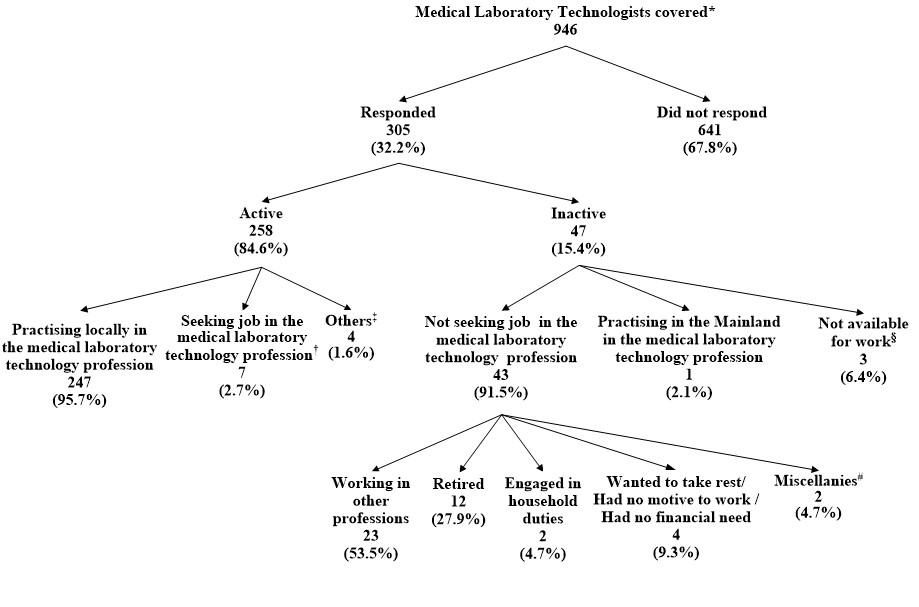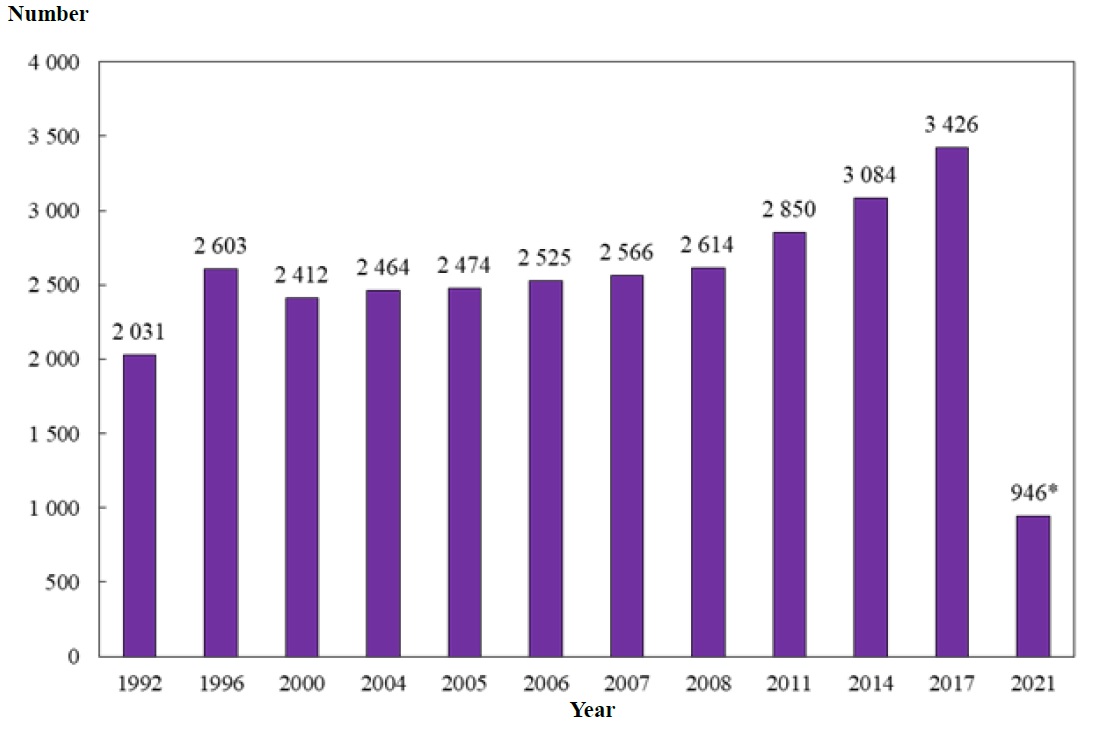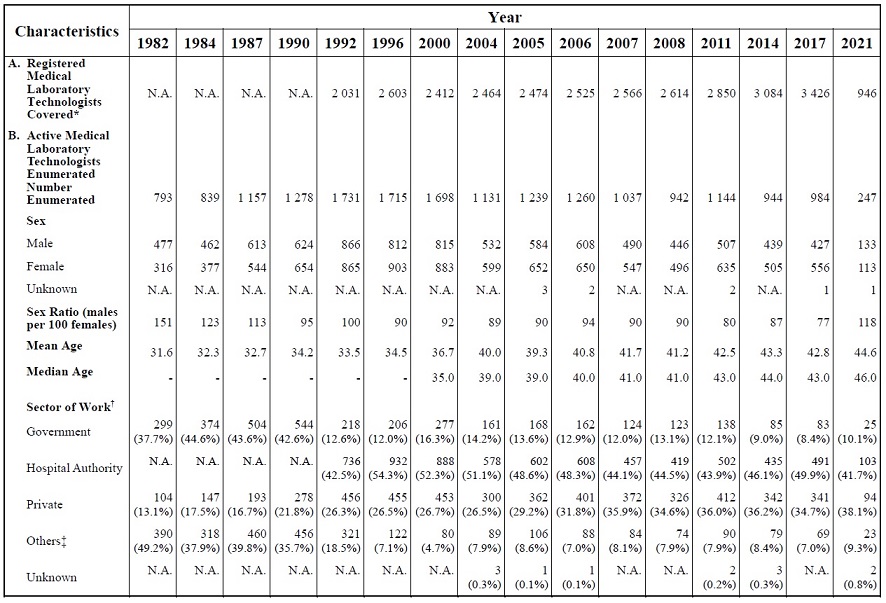Statistics
2021 Health Manpower Survey
Summary of the Characteristics of Medical Laboratory Technologists Enumerated
I. Medical Laboratory Technologists Covered
1.1 The medical laboratory technologists covered in the 2021 Health Manpower Survey on Medical Laboratory Technologists (HMS-MLT) were medical laboratory technologists registered with the Medical Laboratory Technologists Board of Hong Kong under the Supplementary Medical Professions Ordinance (Chapter 359) as at the survey reference date of 31 July 2021, and who had provided written consent on receiving information related to HMS-MLT by post or email.
1.2 Among the 4 125 medical laboratory technologists registered with the Medical Laboratory Technologists Board of Hong Kong as at the survey reference date of 31 July 2021, 946 had consented to receive information related to HMS-MLT by post or email. The number of medical laboratory technologists covered was 946.
II. Response Rate
2.1 Of the 946 medical laboratory technologists covered, 305 responded to the HMS-MLT, giving an overall response rate of 32.2% (Chart A).
III. Activity Status
3.1 The responding medical laboratory technologists were classified as either “economically active”* or “economically inactive”*. Economically active (“active”) medical laboratory technologists included:
(a) “employed” medical laboratory technologists - medical laboratory technologists practising in the medical laboratory technology profession in Hong Kong during the survey period; and
(b) “unemployed” medical laboratory technologists - medical laboratory technologists who (i) were not practising in the local medical laboratory technology profession during the survey period; (ii) had been available for work during the seven days before the survey† AND (iii) had sought work in the local medical laboratory technology profession during the 30 days before the survey‡.
3.2 Economically inactive (“inactive”) medical laboratory technologists referred to the responding medical laboratory technologists who were not practising in the medical laboratory technology profession in Hong Kong during the survey period, excluding those who were on leave during the survey period and who were “economically active” but “unemployed”.
3.3 Among the 305 responding medical laboratory technologists, 258 (84.6%) were active and 47 (15.4%) were inactive in the local medical laboratory technology profession as at 31 July 2021 (Chart A).
| * | In the survey, the criteria used in defining economically active / inactive followed those recommended by the International Labour Organization, which are also being used by the Census and Statistics Department in Hong Kong. |
| † | The respondent would be classified as “unemployed” if he / she had sought work in the local medical laboratory technology profession but had not been available for work because of temporary sickness. |
| ‡ | The respondent would also be classified as “unemployed” if he / she fulfilled conditions (i) and (ii) but had not sought work during the 30 days before enumeration because he / she believed that work was not available; or had made arrangements to take up a new job; or was starting business on a subsequent date; or was expecting to return to the original job in the local medical laboratory technology profession. |
3.4 Among the 258 active medical laboratory technologists, 247 (95.7%) were practising in the local medical laboratory technology profession, seven (2.7%) were seeking jobs in the local medical laboratory technology profession, four (1.6%) reported that they were available for work but had not sought work during the 30 days before the enumeration as they believed no work available in the profession; were starting business in the profession at subsequent date; or were waiting to take up new job in the medical laboratory technology profession. The survey results presented in paragraph 3.5 to 3.15 were based on the 247 responding medical laboratory technologists who were practising in the local medical laboratory technology profession as at 31 July 2021. The percentages presented below may not add up to 100% due to missing responses or rounding (Chart A).
3.5 Of the 47 (15.4%) inactive medical laboratory technologists enumerated, 43 (91.5%) reported not seeking jobs in the local medical laboratory technology profession during the 30 days before enumeration, one (2.1%) reported practising in the Mainland, and three (6.4%) were not available for work during the seven days before the survey due to other reasons. Among the 43 inactive medical laboratory technologists who reported not seeking jobs in the local medical laboratory technology profession, the main reasons included: 23 (53.5%) were working in other professions, 12 (27.9%) were retired, four (9.3%) wanted to take a rest / had no motive to work / had no financial need, two (4.7%) were engaged in household duties, one (2.3%) was emigrated and one (2.3%) was undertaking study (Chart A).
3.6 Of the 247 active medical laboratory technologists practising in the local medical laboratory technology profession enumerated, there were 133 (53.8%) male, 113 (45.7%) female and one (0.4%) did not indicate the gender, giving an overall sex ratio (males per 100 females) of 118. Excluding two respondents who did not indicate their age, the median age of the remaining 245 was 46.0 years (median age of female was 41.0 years and median age of male was 49.0 years).
3.7 The responding active medical laboratory technologists practising in the local medical laboratory technology profession were requested to indicate the characteristics of their main jobs*. Among the 247 respondents, 103 (41.7%) of them reported as working in the Hospital Authority, 94 (38.1%) in the private sector, 25 (10.1%) in the Government, 23 (9.3%) in the academic and subvented sectors.
3.8 For the active medical laboratory technologists practising in the local medical laboratory technology profession enumerated, the median age for those working in the academic and subvented sectors was 50.0 years, whereas the median ages for those working in the Government, the private sector and the Hospital Authority were 48.0 years, 48.0 years and 40.0 years respectively.
3.9 Of the 247 active medical laboratory technologists practising in the local medical laboratory technology profession enumerated, 71.3% reported spending most of their working time on medical laboratory tests, while 21.9% reported spending most of their working time on administration / management, 2.8% reported research and 2.4% reported teaching as the main area of work.
3.10 The median number of hours of work per week (excluding meal breaks) of the 247 active medical laboratory technologists practising in the local medical laboratory technology profession enumerated was 42.0 hours, amongst which 47 (19.0%) were required to undertake on-call duty (excluding normal duty), with a median of 10.0 hours of on-call duty (excluding normal duty) per week.
3.11 Among the 247 respondents, 31.2% held Bachelor’s Degree, 27.5% held Certificate issued by the Medical Laboratory Technologists Board, 22.7% held Diploma / Higher Diploma and 18.2% held Certificate of Competence / Ordinary Certificate / Higher Certificate as their earliest basic qualification.
| * | Main jobs referred to the jobs in which the medical laboratory technologists had spent most of their working time. |
Chart A : Activity Status of Medical Laboratory Technologists Covered

| Note: | * | Figure refers to the number of medical laboratory technologists who had registered with the Medical Laboratory Technologists Board of Hong Kong under the Supplementary Medical Professions Ordinance (Chapter 359) on or before 31.7.2021, and who had provided written consent to receive information related to HMS-MLT by post or email. |
| † | Figure refers to the number of responding medical laboratory technologists who (a) were not practising in the medical laboratory technology profession in Hong Kong during the survey period; (b) had been available for work during the seven days before the survey; AND (c) had sought work in the local medical laboratory technology profession during the 30 days before the survey. | |
| ‡ | Figure refers to the number of responding medical laboratory technologists who (a) were not practising in the medical laboratory technology profession in Hong Kong during the survey period; (b) had been available for work during the seven days before the survey; AND (c) had not sought work during the 30 days before enumeration because he / she believed that work was not available; or was starting business at subsequent date; or was waiting to take up a new job in the local medical laboratory technology profession. | |
| § | Figure refers to the number of responding medical laboratory technologists who (a) were not practising in the medical laboratory technology profession in Hong Kong during the survey period; and (b) had not been available for work during the seven days before the survey due to other reasons. | |
| # | Figure refers to the number of responding medical laboratory technologists who reported undertaking study or emigrated. | |
| Percentages may not add up to 100% due to rounding. |
3.12 Of the 247 respondents, 152 (61.5%) had received / were receiving additional training after obtaining their earliest basic qualification, amongst which 83 (54.6%) held Master’s Degree, 23 (15.1%) held Bachelor’s Degree, 11 (7.2%) held Doctoral Degree, nine (5.9%) held Certificate, eight (5.3%) held Higher Certificate, four (2.6%) held Post-graduate Diploma, one (0.7%) held Associate Diploma as the highest qualification and eight (5.3%) had not yet completed the additional training.
3.13 Of the 152 respondents who had received / were receiving additional training after obtaining their earliest basic qualification, 94 (61.8%) had received / were receiving training in one field only, which included training in Medical Laboratory Sciences (27.7%), Biomedical Sciences (26.6%), Medical Laboratory Technology (11.7%), Medical Microbiology (9.6%), Haematology and Serology (4.3%), Pathology (4.3%) and Health Care Management / Health Services Management (3.2%).
3.14 Of the 152 active medical laboratory technologists practising in the local medical laboratory technology profession who had received / were receiving additional training after obtaining their earliest basic qualification, 57 (37.5%) indicated that they had received / were receiving more than one field of additional training. The most commonly reported fields included: Medical Laboratory Sciences which was reported by 41 (71.9%) of the 57 respondents, Biomedical Sciences which was reported by 37 (64.9%) of the respondents, Medical Laboratory Technology which was reported by 31 (54.4%) of the respondents, Haematology and Serology which was reported by 24 (42.1%) of the respondents, Medical Microbiology which was reported by 16 (28.1%) of the respondents, Pathology which was reported by 16 (28.1%) of the respondents and Health Care Management / Health Services Management which was reported by five (8.8%) of the respondents.
3.15 Among the 247 active medical laboratory technologists practising in the local medical laboratory technology profession, 126 (51.0%) reported that they had participated in Continuing Professional Development (CPD) activities in 2021, 115 (46.6%) reported no participation in any CPD activities and six (2.4%) did not report whether they had participated in any CPD activities or not. Among the 126 respondents who had participated in CPD activities, the distribution of CPD credits attained in the past 12 months was: 1 to 10 points (63.5%), 11 to 20 points (24.6%), 21 to 30 points (6.3%), 31 to 40 points (0.8%) and more than 40 points (4.8%).
IV. Trend Analysis
4.1 As there have been changes to the survey method, reference date and coverage for 2021 HMS-MLT, findings of the survey cannot be directly comparable to previous surveys.
4.2 The medical laboratory technologists covered in the 2021 HMS-MLT were those registered with the Medical Laboratory Technologists Board of Hong Kong as at 31 July 2021, and who had provided written consent on receiving information related to HMS-MLT by post or email. The scope covered in 2021 is different from the previous surveys and constituted approximately 23% of the medical laboratory technologists registered with the Medical Laboratory Technologists Board of Hong Kong under the Supplementary Medical Professions Ordinance (Chapter 359) as at the survey reference date.
4.3 Selected characteristics of active medical laboratory technologists practising in the local medical laboratory technology profession enumerated during the survey years between 1982 and 2021 were tabulated in Table A for reference.
4.4 With the introduction of practising certificate by the Medical Laboratory Technologists Board of Hong Kong in October 1990, the method adopted in counting medical laboratory technologists was changed to include medical laboratory technologists who had valid practising certificates in medical laboratory technology as at the survey reference date. Survey coverage for 1992-2017 is summarised as follows:
- The medical laboratory technologists covered in 1992, 1996 and 2000 were the medical laboratory technologists registered with the Medical Laboratory Technologists Board of Hong Kong as at 1 July of the respective years.
- The medical laboratory technologists covered from 2004 to 2017 were medical laboratory technologists registered with the Medical Laboratory Technologists Board of Hong Kong as at 31 March of the respective years, excluding those who were later found to have passed away on or before the survey reference date.
4.5 Given the changing survey methodologies, the number of medical laboratory technologists covered ranged between 946 and 3 426 during the survey years between 1992 and 2021.
Chart B : Number of Medical Laboratory Technologists Covered by Year (1992, 1996, 2000, 2004, 2005, 2006, 2007, 2008, 2011, 2014, 2017 and 2021)

| Note: | * | Figure of 2021 refers to the number of medical laboratory technologists who had registered with the Medical Laboratory Technologists Board of Hong Kong on or before 31 July 2021 and who had provided written consent to receive information related to HMS-MLT by post or email. |
| Figures of the year 2000 and before refer to the number of medical laboratory technologists registered with the Medical Laboratory Technologists Board of Hong Kong as at the 1 July of the respective years, whereas the figures of 2004 to 2017 refer to that as at the 31 March of the respective years. |
Table A : Selected Characteristics of Active Medical Laboratory Technologists Practising in the Local Medical Laboratory Technology Profession Enumerated (1982, 1984, 1987, 1990, 1992, 1996, 2000, 2004, 2005, 2006, 2007, 2008, 2011, 2014, 2017 and 2021)

| Note: | * | Figures of 1992, 1996 and 2000 refer to the number of medical laboratory technologists registered with the Medical Laboratory Technologists Board of Hong Kong as at the 1 July of the respective years, whereas the figures of 2004 to 2017 refer to that as at the 31 March of the respective years. The number covered in 2021 were medical laboratory technologists who had registered with Medical Laboratory Technologists Board of Hong Kong under the Supplementary Medical Professions Ordinance (Chapter 359) on or before 31 July 2021 and who had provided written consent to receive information related to HMS-MLT by post or email. |
| † | In 2006, 2007, 2008, 2011, 2014, 2017 and 2021, the sector refers to the sector for the main job. | |
| ‡ | Included academic and subvented sectors. Military sector was included in the 1987 HMS and 1996 HMS. There may be slight discrepancy between the sum of individual items and the total due to rounding. |
|
| N.A. | Not applicable | |
| ‘-’ | Not available |